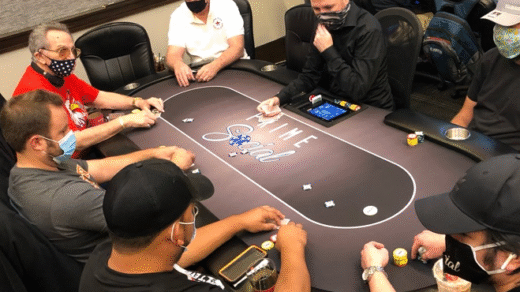Texas Hold ‘Em Poker is a game that rewards good play. There’s some luck involved, but a good player will beat bad players the vast majority of the time if you know the rules. To increase your chances of winning the game know some of the key Texas Hold ‘Em strategies, such as understanding your position, focusing on other players’ moves, knowing when and why to fold a hand, and learning how to narrow the field of players.
Know Your Position
The best position in Texas Hold ‘Em is “on the button.” When you’re on the button, you’re the last person to act in three out of the four betting rounds—after the flop, the turn, and the river. When it’s your turn, you have full knowledge of how many other players are still in the hand, and you can make a much more informed decision on how much to bet if any.
The worst position is the small blind. After the flop, the turn, and the river, you must act first. Sometimes you can use this to your advantage by playing aggressively, but it’s much better to act last.
Also, focus on the total number of players remaining at the table. A hand that shouldn’t be played with seven players could be strong when you’re down to two or three since there’s less competition at the table. Also, the fewer players there are, the more often you’re forced to bet (the blinds), so you have to be more aggressive.
Concentrate on the Other Players
It’s easy to get caught up in your hand and lose sight of the other players. But you need to be aware of how many chips they have (a rough count, not necessarily a specific count), what cards they could have, and what their best hand could be given the community cards you share with everyone else.
Watching player trends can also be helpful. Try to determine who bluffs and who plays a tighter game. If a player has consistently never bet more than $10 and suddenly comes in with a $50 bet, you should be wary. It’s a good indication that the player has something solid.
If a player loses a fairly big hand and then comes right back with a big bet, that player may be betting recklessly out of frustration. This is not a bad time to push back—as long as you have a solid hand to do it with—because someone playing like that isn’t likely to fold.
Don’t Let Other Players See the Flop for Free
If you have a hand that’s strong enough to see the flop, don’t let other players see it for free—at least raise by the minimum bet. Beginners love to see the flop as cheaply as possible, but it’s dangerous to let them do it.
Say your hand is an A-K and the other players have a 7-4 and a 10-5. You should be able to get both of them out of the hand before the flop. But if you let them see the flop for just the price of the big blind, disaster could strike. In this case, a 10-9-8 would be about the worst—you have nothing, and one of your opponents has an open-ended straight draw while the other has a pair of 10s. You’ve wasted a great starting hand.
Don’t Be Afraid to Get out After the Flop
Folding a hand after the flop is difficult for some beginning players. “I’ve already put money into the pot, so I might as well stay in and see what happens,” they reason. But that kind of thinking can cause you to lose a lot of chips.
Even if you start with a great hand, the flop could kill you. Say you have an A-K but the flop comes up J-J-5. That does you no good, and if someone else has a J you’re suddenly a big underdog. Even if an A or K, or both, come up, you’ll lose to the three Js. If the flop doesn’t improve your hand, and you’re not holding a big pair, think hard about getting out.
Sometimes, you should get out after the flop even when you might think it’s gone your way. Let’s say you stayed in with a Q-6, and the flop is K-10-6. A natural tendency is to concentrate on what went right—”Isn’t it grand? I have a pair of 6s!” but the K and the 10 are very dangerous—you have the low pair, meaning that any other player with a K or a 10 is ahead of you.
Play Smart on the Turn and the River
Following these simple tips will help make you a better player at the turn and the river.
- If you’re holding a draw after the turn—i.e. you need one more card to make a good hand, typically a straight or a flush—try to get to the river as cheaply as possible.
- If you’re sure you have the best possible hand after the turn, make it expensive for opponents to see the river.
- If the community cards include a pair, remember that you might be up against a full house.
- If the board shows three cards of the same suit, watch out for an opponent holding a flush.
After the river, your decision to check, bet, fold, or call can only be based on the realized value of your cards – you no longer have the potential to improve your hand. If you think your opponent has a better hand, it’s usually unwise to bluff here.
Read Next : How To Play Poker : the basic rules common to all types of poker


